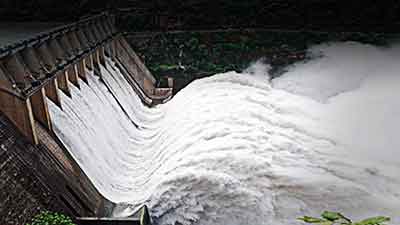Date: 07/02/2023
Relevance: GS-3: Conservation, environmental pollution and degradation, environmental impact assessment.
Key Phrases: Economic Development, Environmental Preservation, Hydropower Projects, Himalayan Region, Micro Hydro Systems, Hydropower Projects, Ecosystem.
Context:
- The recent crisis in Joshimath and the previous glacier burst have brought attention to the impact of hydropower projects on the Himalayan region.
- It has sparked debates about the balance between economic development and environmental preservation in the region.
Key Highlights:
- Hydropower is often considered green energy because it generates electricity from the natural flow of water without releasing any emissions or pollutants. It also does not rely on fossil fuels.
- However, the effects of hydropower projects on the environment
can differ based on the specifics of each project and the methods used to
implement it.
- The construction and operation of large scale hydroelectric dams often result in significant changes to the local ecosystem and the displacement of communities.
- This can lead to a reduction in habitat for fish and other wildlife, and have a detrimental effect on the environment. The building and upkeep of these large hydroelectric dams can also contribute to environmental degradation.
Himalayas as Water Source:
- The Himalayas is a major water source for much of South Asia. Most countries in the region, including India, China, Nepal, Bhutan, and Pakistan, have built or are planning to build hydropower projects in the Himalayas.
- In India, the government has identified hydropower as a key renewable
energy source. Many hydropower projects are under construction or in the
planning stages in the Indian Himalayas.
- This includes the Subansiri Lower Hydroelectric Project in Arunachal Pradesh and the Teesta Low Dam Hydroelectric Project in Sikkim.
- Nepal has also identified hydropower as a major source of energy. It has many hydropower projects in the planning and development stages, including the Arun III Hydroelectric Project and the West Seti Hydroelectric Project.
- In Bhutan, hydropower is the main source of revenue, and the
government has set a target to export surplus electricity to India.
- The country has built several hydropower projects, including the Chukha Hydropower Project and the Tala Hydropower Project.
The Hidden Cost of Hydropower:
- The construction of hydropower projects in the Himalayan region has
been the source of much debate.
- In addition to environmental impacts, such as those seen in Joshimath and other areas of Uttarakhand, there are also worries about potential water resource conflicts.
- The Himalayas are home to a rich array of flora and fauna and the
ecosystem is delicate, making it vulnerable to the effects of deforestation,
overgrazing, and other harmful construction activities.
- These actions not only harm the environment but also negatively impact the livelihoods of local communities who depend on the ecosystem.
- Constructing dams can affect river flow and alter water
temperature and chemical composition, leading to erosion, landslides, and
sediment buildup that harm the surrounding environment.
- They can also disrupt the migratory patterns of fish and other aquatic life, particularly if the dam construction results in habitat destruction.
- The construction of large-scale hydroelectric dams often leads to the displacement of local communities, negatively impacting their livelihoods and cultural heritage, and resulting in a decline in the overall well-being of the affected population.
The Alternatives to Hydropower:
- Micro Hydro System can be an alternative to it. Micro hydro refers to small-scale hydroelectric power generation systems with a capacity of up to 100 kilowatts (kW).They use the energy of falling water to turn a turbine, generating electricity.
- Micro hydro systems can be classified into two main types –
run-of-river and storage systems.
- Run-of-river systems use the natural flow of water in a stream or river to generate electricity. In contrast, storage systems use a reservoir to store water and release it as needed to generate electricity
- Micro hydro systems are typically less expensive to build and
maintain than large hydroelectric dams and have a smaller environmental
footprint.
- They can be located even in inaccessible areas where it is difficult to transmit electricity from larger power stations, and they can provide a reliable source of energy to communities that are not connected to the grid.
Conclusion:
- Micro hydro systems can be tailored to minimise the ecosystem’s
negative impact and provide sustainable energy solutions.
- However, it’s important to note that even micro-hydropower projects can have some impact on the environment and local communities.
- Citizens’ engagement and public consent mechanisms need to be strengthened at the planning stage and a grievance redressal mechanism for addressing issues brought forth by public needs to be put in place post clearance.
- There should be an independent inquiry or audit of the social, environmental and safety norms compliance of all under-construction and operational projects, specifically projects where accidents have already been reported.
Source: The Indian Express
Mains Question:
Q. Hydropower projects in the Himalayas should be reconsidered given the recent crisis in the Himalayan region. Discuss (150 words).






















